20 March 2025
|
DNA testing has become an essential tool for family historians, helping to solve mysteries and uncover hidden family connections. In this interview, genetic genealogist Michelle Leonard shares how she got her start with DNA, what excites her about genetic genealogy, and her advice for anyone wanting to use DNA in their research.
How did you first get into DNA?
I first got into DNA back in 2009 through my work on the ground-breaking Fromelles Genealogy Project.
I spent several years tracking down appropriate DNA donors to help identify WWI soldiers buried in a mass grave in Northern France. I had never really thought of myself as a ‘science’ person, but I threw myself into learning how the different types of DNA worked and became completely fascinated.
That foundation gave me a huge head start when DNA testing took off in the genealogy world – I was excited by the possibilities and ready to dive in thanks to Fromelles!
What do you really enjoy about DNA?
I enjoy the mystery-solving aspect the most! I think that’s why I like the term ‘DNA detective’ as it perfectly describes what I do.
I love nothing better than working on a fresh set of DNA results, immersing myself in an unknown ancestor mystery and being able to piece together the genetic jigsaw puzzle. Every case is different, and the thrill of discovery never gets old!
Michelle will be speaking at this year's DNA Discoveries online event!
WATO? Plus: Unlocking DNA Clues with DNA Painter's Key Power Tool
Date & Time: 16 April, 6:30 PM
Speaker: Michelle Leonard
Details: ‘WATO is a tool that helps you work out how a specific DNA tester fits into a particular family group and I think at some point EVERYONE will need or want to use WATO!’ says Michelle Leonard. Join us for Michelle’s presentation and learn how it can help you.
Tickets: Buy Individual Ticket - £12 | Buy Bundle
Can you recall a lightbulb moment when using DNA?
There have been so many that it’s hard to pick just one!
A major moment came early on after I received my first autosomal DNA results when I proactively built out the tree of a DNA match, identified our connection, and it dawned on me that I could try to do this over and over again with so many other matches!
That was the moment it truly clicked that DNA could be the key to breaking through my own brick walls. That first success set me on the path to making DNA a core part of my genealogy work.
What’s your top tip you’d like to share for people using DNA for family history?
Test your older generation relatives whenever you can! They carry more of your ancestors’ DNA than you do, so their results are incredibly valuable for identifying connections and unlocking family mysteries. Once their DNA is gone, so is that opportunity – so don’t wait!
Tell us about the DNA education activities you’re involved in
I create and teach a range of DNA courses and webinars throughout the year for family history organisations worldwide, including Family Tree Plus (DNA Club), Family Tree, Family History Academy, Legacy Family Tree Webinars, and more.
Tell us about any DNA projects or organisations that you’re involved with
I’m an FTDNA project admin, though in more of a backseat role at the moment due to other commitments. I’d love to dedicate more time to it in the future, as these projects can be incredibly valuable for genetic genealogy research.
Find out more about Michelle’s forthcoming talks at: www.facebook.com/genesandgenealogy








